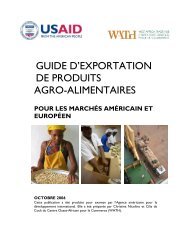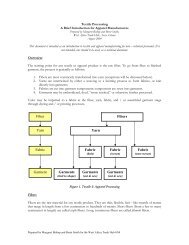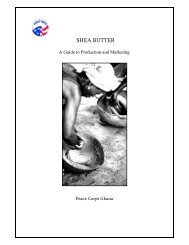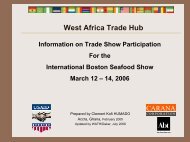A Value Chain Analysis of the Cashew Sector - AGOA Export Toolkit
A Value Chain Analysis of the Cashew Sector - AGOA Export Toolkit
A Value Chain Analysis of the Cashew Sector - AGOA Export Toolkit
You also want an ePaper? Increase the reach of your titles
YUMPU automatically turns print PDFs into web optimized ePapers that Google loves.
1 Introduction<br />
1.1 Background Information on <strong>the</strong> African <strong>Cashew</strong><br />
Initiative and <strong>the</strong> Purpose <strong>of</strong> <strong>the</strong> Country Study<br />
Many African countries have considerable comparative advantages<br />
within <strong>the</strong> agricultural sector at <strong>the</strong>ir disposal based<br />
on <strong>the</strong>ir natural resources. Moreover, globalisation provides<br />
opportunities for integrating developing countries into <strong>the</strong><br />
global economy and can <strong>the</strong>reby reveal options for building<br />
up and streng<strong>the</strong>ning national economies. In this context,<br />
African countries could use <strong>the</strong> comparative advantages <strong>the</strong>y<br />
have to signifi cantly increase <strong>the</strong>ir share <strong>of</strong> international economic<br />
growth and, thus, support <strong>the</strong>ir own sustainable economic<br />
development and poverty alleviation.<br />
<strong>Cashew</strong>s are grown in Africa, Latin America and South East<br />
Asia. Th e leading producer countries are India, Vietnam, Brazil<br />
and Indonesia. Increasingly, Africa is gaining importance in<br />
raw cashew nut production. Here, <strong>the</strong> main producer countries<br />
are Nigeria, Tanzania, Mozambique, Côte d’Ivoire and Guinea<br />
Bissau 1 , while countries such as Ghana, Burkina Faso and Benin<br />
are currently expanding areas under cultivation. Although <strong>the</strong><br />
global market for cashew kernels is steadily growing, it is dominated<br />
by a small number <strong>of</strong> traders. West African cashews are<br />
predominantly exported as unprocessed raw cashew nuts.<br />
On average, 90% <strong>of</strong> <strong>the</strong> raw nuts produced in this region are<br />
exported to India.<br />
Figure 1.1 World <strong>Cashew</strong> Production<br />
World <strong>Cashew</strong> Production<br />
Estimated world raw cashew produktion<br />
by region and country in million kgs<br />
800<br />
700<br />
600<br />
500<br />
400<br />
300<br />
200<br />
100<br />
Source: Red River Foods Inc. /FAO<br />
0<br />
1998<br />
1999<br />
2000<br />
2001<br />
20 2002<br />
In 2007, African farmers accounted for about 40% <strong>of</strong> total<br />
global cashew nut production. Th ese are mostly poor smallholders<br />
who grow cashews under diversifi ed cropping systems.<br />
<strong>Cashew</strong> nut production is an important source <strong>of</strong> income for<br />
many Ghanaian smallholder farmers. Agriculture, as a whole,<br />
dominates Ghana’s economy – in 2008, agricultural activities<br />
contributed to 33.6% <strong>of</strong> GDP, employed about 60% <strong>of</strong> <strong>the</strong><br />
labour force, and accounted for 54% <strong>of</strong> foreign exchange earnings<br />
(Ghana Statistical Service, 2008). Th e sector itself is composed<br />
<strong>of</strong> fi ve sub-sectors, namely crops o<strong>the</strong>r than cocoa (49%<br />
<strong>of</strong> agricultural GDP), cocoa (22.5% <strong>of</strong> agricultural GDP), livestock<br />
(5.5% <strong>of</strong> agricultural GDP), fi sheries (12.2% <strong>of</strong> agricultural<br />
GDP), and forestry (9.9% <strong>of</strong> agricultural GDP).<br />
Non-traditional crops, such as pineapple, mango and cashew<br />
nuts, are increasingly <strong>of</strong> importance to Ghana’s economy. Th e<br />
last six years have seen growing interest in cashew cultivation<br />
across <strong>the</strong> country. Th is is because <strong>of</strong> <strong>the</strong> crop’s importance to<br />
farm families, coupled with <strong>the</strong> presence <strong>of</strong> high demand and<br />
a fl ourishing export market. Since cashew is harvested during<br />
<strong>the</strong> lean season for all major staples (e.g. maize, yam, plantain<br />
and millet), this crop could help avoid food purchases and<br />
contribute to increased food security (personal comment by<br />
Peter Gyan, 2009).<br />
However, most <strong>of</strong> <strong>the</strong> time, African farmers face several constraints<br />
that hinder <strong>the</strong>m in increasing <strong>the</strong> pr<strong>of</strong>i tability <strong>of</strong><br />
<strong>the</strong>ir cashew production. Th ese would include: low tree pro-<br />
India Vietnam Brazil West Africa East Africa O<strong>the</strong>r<br />
2003<br />
2004<br />
20 2005<br />
2006<br />
2007<br />
2008<br />
1 Th is is a listing ra<strong>the</strong>r than a ranking as fl uctuations in<br />
production (which also depend on <strong>the</strong> quality <strong>of</strong> information sources)<br />
do not allow for a defi nite yearly ranking.<br />
11









